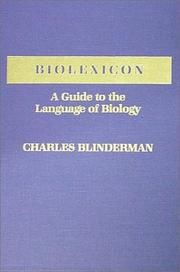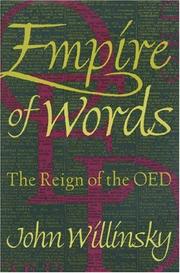| Listing 1 - 6 of 6 |
Sort by
|
Book
ISBN: 311049731X 3110495996 3110493578 9783110497311 9783110497328 3110497328 9783110493573 9783110495997 Year: 2017 Volume: 95 Publisher: Berlin De Gruyter
Abstract | Keywords | Export | Availability | Bookmark
 Loading...
Loading...Choose an application
- Reference Manager
- EndNote
- RefWorks (Direct export to RefWorks)
Despite its exceptional frequency and versatility, GET has never been a focus of research in its entire variability, which goes from lexical to grammatical uses, nor in large amounts of data from different varieties of English. The present corpus-based study deals with over 11,600 tokens of GET in written and spoken language from three varieties of English and thus provides new insights for variationist linguistics. Firstly, it offers a comprehensive semasiological-syntactic analysis of GET, i.e. an analysis of all its meanings and all the constructions into which it enters, suggesting ten categories as being necessary for its complete description. Secondly, it contributes to the understanding of factors that are at work in variation in World Englishes and lead to quantitative differences between regional standard varieties. Thus, the present study demonstrates that the use of GET in the New Englishes analysed is less affected by substrate effects than by the effects of Second Language Acquisition and the varying influence of British and American English norms. Moreover, it can be shown that the New Englishes display more grammatical uses of GET than does British English.
Corpora (Linguistics) --- Corpus-based analysis (Linguistics) --- Corpus linguistics --- Linguistic analysis (Linguistics) --- E-books --- Get (The English word) --- English language --- Semantics --- Etymology --- English language - Semantics --- English language - Etymology --- Corpus Linguistics. --- GET. --- Lexis-Grammar Continuum. --- World Englishes.
Book
ISBN: 9780191667060 0191667064 1306300231 9781306300230 9780199574995 0199574995 0191667072 0198736495 Year: 2014 Publisher: Oxford Scholarship Online
Abstract | Keywords | Export | Availability | Bookmark
 Loading...
Loading...Choose an application
- Reference Manager
- EndNote
- RefWorks (Direct export to RefWorks)
"The rich variety of the English vocabulary reflects the vast number of words it has taken from other languages. These range from Latin, Greek, Scandinavian, Celtic, French, Italian, Spanish, and Russian to, among others, Hebrew, Maori, Malay, Chinese, Hindi, Japanese, and Yiddish. Philip Durkin's full and accessible history reveals how, when, and why. He shows how to discover the origins of loanwords, when and why they were adopted, and what happens to them once they have been."--Publishers website.
802.0-02 --- 802.0-02 Engels. Engelse taalkunde--?-02 --- Engels. Engelse taalkunde--?-02 --- Comparative linguistics. --- English language --- Etymology. --- Comparative linguistics --- Etymology --- Words --- History --- English language - Etymology --- English language - Words - History --- Historical linguistics --- Germanic languages
Book
ISBN: 9783110251593 3110251590 3110251604 9783110251609 9783110251609 9783110202205 9783110202656 3110202654 3112146697 3110202204 9783112146699 Year: 2012 Volume: 34/1-2 34/1-2 34/1-2 Publisher: Berlin ; Boston : De Gruyter Mouton,
Abstract | Keywords | Export | Availability | Bookmark
 Loading...
Loading...Choose an application
- Reference Manager
- EndNote
- RefWorks (Direct export to RefWorks)
n.a.
Historical linguistics --- English language --- English language -- Etymology. --- English language -- History. --- Historical linguistics. --- English --- Languages & Literatures --- English Language --- History --- Diachronic linguistics --- Dynamic linguistics --- Evolutionary linguistics --- Language and languages --- Language and history --- Linguistics --- History. --- Etymology --- Word history --- Germanic languages --- English language - History --- English Linguistics. --- Language History.

ISBN: 0398082278 9780398082277 0398056714 9780398056711 0398060231 9780398060237 Year: 1990 Publisher: Springfield : Charles C Thomas,
Abstract | Keywords | Export | Availability | Bookmark
 Loading...
Loading...Choose an application
- Reference Manager
- EndNote
- RefWorks (Direct export to RefWorks)
The vocabulary of biology is made easier through knowing the meanings of elements that make up whole words. English continues to adopt words from foreign languages and to build its vocabulary by inventing new words from old elements. Most of the words entering English every year reside in technical vocabularies and knowing what the elements mean prepares medical students and physicians, the practitioner of any biological science, and anyone else to decipher these new words that might name a newly discovered microbe or mastodon, a disease, or a surgical procedure.
Biology -- Terminology. --- English language -- Etymology. --- Nomenclature. --- Biology --- English language --- Biological Science Disciplines --- Dictionary --- Linguistics --- Publication Formats --- Natural Science Disciplines --- Language --- Disciplines and Occupations --- Communication --- Publication Characteristics --- Information Science --- Terminology as Topic --- Terminology --- Health & Biological Sciences --- Biology - General --- Communication Programs --- Communications Personnel --- Misinformation --- Personal Communication --- Social Communication --- Communication Program --- Communication, Personal --- Communication, Social --- Communications, Social --- Personnel, Communications --- Program, Communication --- Programs, Communication --- Social Communications --- Dialect --- Dialects --- Languages --- Natural Sciences --- Physical Sciences --- Discipline, Natural Science --- Disciplines, Natural Science --- Natural Science --- Natural Science Discipline --- Physical Science --- Science, Natural --- Science, Physical --- Sciences, Natural --- Sciences, Physical --- Linguistic --- Biologic Sciences --- Biological Science --- Science, Biological --- Sciences, Biological --- Biological Sciences --- Life Sciences --- Biologic Science --- Biological Science Discipline --- Discipline, Biological Science --- Disciplines, Biological Science --- Life Science --- Science Discipline, Biological --- Science Disciplines, Biological --- Science, Biologic --- Science, Life --- Sciences, Biologic --- Sciences, Life --- Etymology --- Nomenclature as Topic --- Etymologies --- Dictionaries as Topic --- Unified Medical Language System --- Information Sciences --- Science, Information --- Sciences, Information --- Word history --- History --- Biology - Terminology. --- English language - Etymology. --- Germanic languages

ISBN: 0691037191 9786612751967 1400821355 1282751964 1400813840 9781400813841 9780691037196 Year: 1994 Publisher: Princeton, N.J. Princeton University Press
Abstract | Keywords | Export | Availability | Bookmark
 Loading...
Loading...Choose an application
- Reference Manager
- EndNote
- RefWorks (Direct export to RefWorks)
What is the meaning of a word? Most readers turn to the dictionary for authoritative meanings and correct usage. But what is the source of authority in dictionaries? Some dictionaries employ panels of experts to fix meaning and prescribe usage, others rely on derivation through etymology. But perhaps no other dictionary has done more to standardize the English language than the formidable twenty-volume Oxford English Dictionary in its 1989 second edition. Yet this most Victorian of modern dictionaries derives its meaning by citing the earliest known usage of words and by demonstrating shades of meaning through an awesome database of over five million examples of usage in context. In this fascinating study, John Willinsky challenges the authority of this imperial dictionary, revealing many of its inherent prejudices and questioning the assumptions of its ongoing revision. "Clearly, the OED is no simple record of the language `as she is spoke,'" Willinsky writes. "It is a selective representation reflecting certain elusive ideas about the nature of the English language and people. Empire of Words reveals, by statistic and table, incident and anecdote, how serendipitous, judgmental, and telling a task editing a dictionary such as the OED can be." Willinsky analyzes the favored citation records from the three editorial periods of the OED's compilation: the Victorian, imperial first edition; the modern supplement; and the contemporary second edition composed on an electronic database. He reveals shifts in linguistic authority: the original edition relied on English literature and, surprisingly, on translations, reference works, and journalism; the modern editions have shifted emphasis to American sources and periodicals while continuing to neglect women, workers, and other English-speaking countries. Willinsky's dissection of dictionary entries exposes contradictions and ambiguities in the move from citation to definition. He points out that Shakespeare, the most frequently cited authority in the OED, often confounds the dictionary's simple sense of meaning with his wit and artfulness. He shows us how the most famous four-letter words in the language found their way through a belabored editorial process, sweating and grunting, into the supplement to the OED. Willinsky sheds considerable light on how the OED continues to shape the English language through the sometimes idiosyncratic, often biased selection of citations by hired readers and impassioned friends of the language. Anyone who is fascinated with words and language will find Willinsky's tour through the OED a delightful and stimulating experience. No one who reads this book will ever feel quite the same about Murray's web of words.
English language --- Encyclopedias and dictionaries --- Etymology --- History and criticism --- Lexicography --- History and criticism. --- Etymology. --- Lexicography. --- OED --- Oxford English dictionary --- -English language --- -Encyclopedias and dictionaries --- -Books of knowledge --- Cyclopedias --- Dictionaries --- Encyclopedias and dictionaries, English --- Knowledge, Books of --- Subject dictionaries --- Reference books --- Germanic languages --- Oxford English dictionary. --- Word history --- History --- New English dictionary on historical principles --- English language - Etymology --- Encyclopedias and dictionaries - History and criticism --- English language - Lexicography
Multi
ISBN: 9781107552074 9781107013483 9781139004206 9781107306424 1107306426 9781107314177 1107314178 1139004204 1107013488 9781299257221 1299257224 1107234921 9781107234925 1107301343 9781107301344 1107552079 1107305551 9781107305557 1107308623 9781107308626 1107311977 Year: 2013 Publisher: Cambridge : Cambridge University Press,
Abstract | Keywords | Export | Availability | Bookmark
 Loading...
Loading...Choose an application
- Reference Manager
- EndNote
- RefWorks (Direct export to RefWorks)
Martin Hilpert combines construction grammar and advanced corpus-based methodology into a new way of studying language change. Constructions are generalizations over remembered exemplars of language use. These exemplars are stored with all their formal and functional properties, yielding constructional generalizations that contain many parameters of variation. Over time, as patterns of language use are changing, the generalizations are changing with them. This book illustrates the workings of constructional change with three corpus-based studies that reveal patterns of change at several levels of linguistic structure, ranging from allomorphy to word formation and to syntax. Taken together, the results strongly motivate the use of construction grammar in research on diachronic language change. This new perspective has wide-ranging consequences for the way historical linguists think about language change. It will be of particular interest to linguists working on morpho-syntax, sociolinguistics and corpus linguistics.
English language --- Grammar --- Construction grammar --- Grammaire de construction --- Engels: syntaxis; semantiek --- Construction grammar. --- 802.0-56 Engels: syntaxis; semantiek --- Linguistic change --- 802.0-56 --- Change, Linguistic --- Language change --- Historical linguistics --- Language and languages --- Grammar, Comparative and general --- Usage --- Analysis and parsing --- Diagraming --- Composition and exercises --- Linguistic change. --- Grammar. --- Usage. --- Word formation --- Etymology --- Anglais (langue) --- Changement linguistique --- Grammaire --- Grammaire de construction. --- Changement linguistique. --- Grammaire. --- Arts and Humanities --- Language & Linguistics --- English language Usage --- Germanic languages --- English language - Word formation --- English language - Etymology
| Listing 1 - 6 of 6 |
Sort by
|

 Search
Search Feedback
Feedback About
About Help
Help News
News